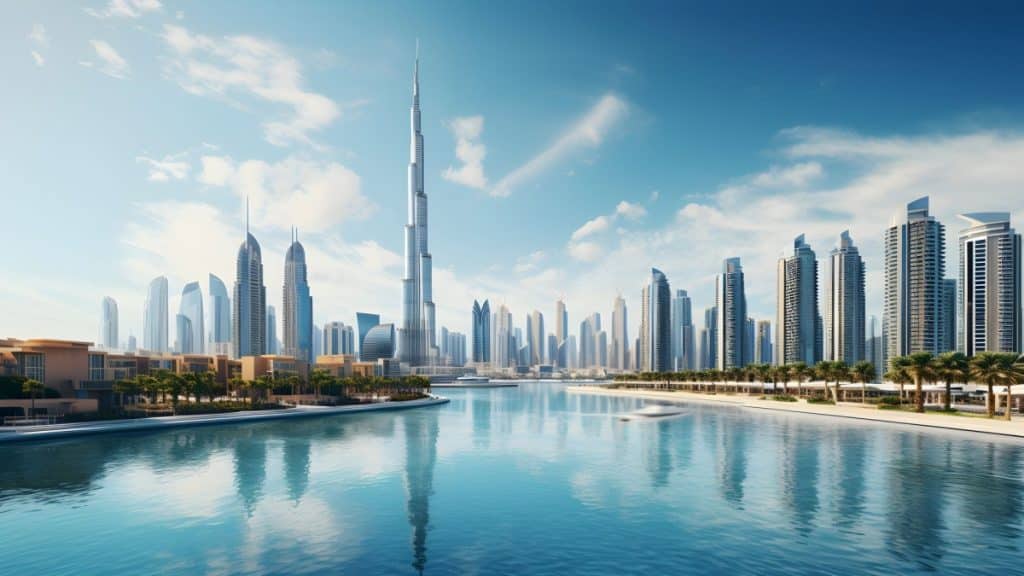Over the past few decades, Dubai has transformed from a quiet desert town into a bustling metropolis brimming with world-class real estate projects. Its population hasdoubled in the past 12 years, driven by an influx of entrepreneurs, professionals, and families seeking a better quality of life. While tourism plays a significant role in its economy, 75% of real estate transactions in Dubai are driven by end-users and long-term investors, reflecting the city’s growing appeal as a permanent home.
The Evolution of Architecture in Dubai
Dubai’s architectural journey began with traditional Arabian-style villas and low-rise buildings, reflecting the region’s cultural heritage and practical needs in a hot desert climate.
The 1970s marked the start of a dramatic change as Dubai began modernizing its infrastructure. High-rise buildings started to dominate the skyline, with the Dubai World Trade Centre, completed in 1979, standing as the city’s tallest building for many years.
The construction of the Burj Al Arab in 1999 was a turning point, setting the tone for Dubai’s architectural ambition. Known as the world’s first “seven-star” hotel, the sail-shaped structure became a global symbol of luxury and innovation. Then came the Burj Khalifa, the world’s tallest building, standing at 828 meters, which cemented the city’s status as an architectural pioneer.
The Current Era: Combining Sustainability and Innovation
Since then, Dubai’s modern architecture has evolved. The emphasis has turned to developing sustainable, livable spaces that prioritize wellness and community living. Developers are infusing green areas, energy-efficient technologies, and smart city concepts into their designs.
The city’s latest projects aim to offer a holistic lifestyle, combining residential, commercial, and leisure spaces in one community. These developments are designed to cater to the city’s growing population, with a focus on convenience, connectivity, and well-being.
Public spaces and recreational areas are becoming key elements in developments, promoting active lifestyles and social interaction. Many new penthouses in Dubai are designed by combining contemporary aesthetics with environmentally conscious practices.
However, despite this shift towards sustainability, Dubai remains as bold as ever, continuing to build remarkable, high-rise developments that defy expectations.
The Most Exciting Upcoming Projects
Currently, there are a lot of high-profile real estate developments, each with its own unique appeal. Here’s a look at some of the most exciting ones:
Emaar Beachfront
Imagine waking up to the sound of waves, stepping out onto your veranda, and suddenly being greeted by a breathtaking ocean view. That is Emaar Beachfront for you. This ultra-luxurious, gated community is situated between Palm Jumeirah and Dubai Marina, providing the ideal blend of urban and beachfront experiences.
Emaar, the organization responsible for the construction of Downtown Dubai and the Burj Khalifa, is currently engaged in the development of the entire region. Consequently, it is no surprise that they are investing heavily. We are discussing 27 towers, each of which features luxury apartments with breathtaking sea vistas. It is intended to evoke the atmosphere of a traditional beach town, complete with a 1.5 km private shoreline, beach clubs, and promenades adorned with restaurants and shops.
Sobha Hartland
Instead of the typical high-rise, ultra-urban atmosphere, Sobha Hartland is an oasis. It is a location that offers the best of both worlds—it is still located in the heart of the city, just a few minutes from Downtown, but without the chaos and commotion. It is luxurious, but in a manner that is slightly more tranquil and in tune with nature.
The entire area is intended to be highly habitable, with all necessary amenities conveniently located within walking distance. The sleek, modern design that is characteristic of Dubai is evident in the luxurious villas, fashionable apartments, and even a few townhouses. And the most delightful aspect? There are numerous parks, gardens, and open spaces, which is exceedingly uncommon in a city that is predominantly recognized for its skyscrapers.
Dubai Creek Harbour
Dubai Creek, the city’s birthplace, is like blending the best components of classic attractiveness with ultra-modern, futuristic emotions. Emaar and Dubai Holding are the driving forces behind this project, and they intend to go big. It will be an area that’s roughly twice the size of Downtown Dubai and is completely master-planned. It is designed to serve as a true urban hub, with parks, boardwalks, retail areas, and plenty of green space.
Then there is Dubai Creek Tower, which was initially designed to be 100 meters taller than the mighty Burj Khalifa, but was redesigned to boast a more elegant structure. It is expected to become the new focal point of the skyline, and once completed, it will most likely become another global icon attracting visitors.
Will Dubai’s Growth Continue?
Dubai’s growth shows no signs of slowing down. Unlike other cities that may face limitations due to space or resources, Dubai’s forward-thinking urban planning and continuous investment in infrastructure give it ample room for expansion. The real estate market, a key driver, remains strong and adaptive. As more professionals and families relocate for long-term opportunities, the demand for high-quality residential communities continues to rise.
With the city’s proactive approach to diversification and innovation, Dubai will likely continue to grow, solidifying its position as one of the world’s most dynamic and future-ready cities. The future of this city is bright, and all the new projects are shaping the next chapter in its remarkable story.


